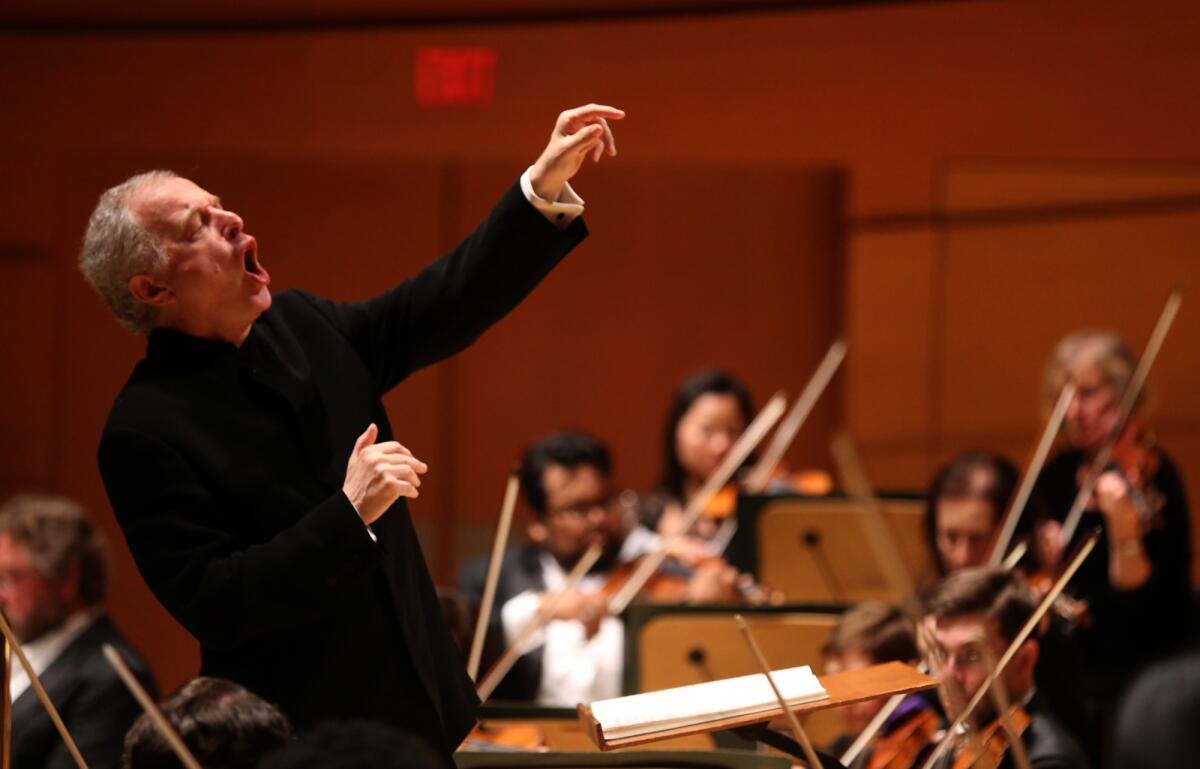Review: András Schiff and the L.A. Philharmonic join Haydn for a look at war

Pianist Andras Schiff conducts the Los Angeles Philharmonic and the Los Angeles Master Chorale who perform Haydn’s, “Mass in the Time of War” at the Walt Disney Concert Hall.
- Share via
When Haydn wrote on top of his 1796 Mass in C major “Missa in tempore belli,” Napoleon’s troops threatened the borders of the Austrian empire. A decree had been issued that year that the word “peace” not be uttered until victory was at hand. Haydn’s contribution to the cause was this “Mass in Time of War.”
Of course, the last words of the traditional mass text are “dona nobis pacem” — grant us peace. They are first uttered quietly by the chorus, accompanied by a timpani roll underneath like a heart’s nervous palpitation. When repeated, the trumpets blare, the drums pound and the Mass ends with vehemence.
That moment was stirring Thursday night at Walt Disney Concert Hall in a performance of what is also known as Haydn’s “Paukenmesse” (Kettledrum Mass) by the Los Angeles Philharmonic, the Los Angeles Master Chorale and four excellent soloists conducted by András Schiff.
SIGN UP for the free Essential Arts & Culture newsletter >>
This wasn’t stirring in the way Leonard Bernstein’s extraordinary performance of the Mass had been in 1973, when he performed it in the National Cathedral in Washington during Richard Nixon’s second inauguration celebrations. Bernstein’s “Concert for Peace” called for an end to the Vietnam War. He used a huge chorus, shook the rafters in stunning insurrection and transfixed a crowd of 12,000 protesters who stood outside in a freezing rain to listen.
Schiff’s approach was quieter and, in comparison, understated. But it too was dissident.
We don’t know exactly what Haydn, a warm humanist with a magnificent wit, meant the tenth of his 14 Masses to be. Although the “Mass in Time of War” ends more theatrically than typical for a work meant to serve as a religious service, the score’s most remarkable feature is its normality. A “Time of War” is no less a time for clever turns of phrase, inventive formal procedures and harmonic twists. Joyous and somber airs vie for the greater beauty.
Only at the end are there intimations, with distant trumpet calls, disruptive timpani, of threats to life’s delights. Haydn, a national hero who had given the Austrians their new national anthem, wanted Napoleon defeated as much as the next guy. His paean to peace is the reason why.
Schiff put much of his attention to elucidating the special details of Haydn’s score, the many ways that make the music feel alive and of the moment. The orchestra played with fervent understatement, if there is such a thing, and Robert deMaine contributed an eloquent cello solo. The final bars were more solemn than activist. Joseph Pereira used period timpani, taut in their effect. With all the marvels that came before, that was a disquieting indication that subtle threats against peace may be even more dangerous than bellicose ones.
Schiff placed the Mass in an original context that added to its seditious message. The concert began with him conducting Mozart’s Piano Concerto No. 25 from the keyboard. It ended with an unusual post-concert Schubert song recital in which the four vocal soloists and members of the Master Chorale performed with Schiff back at the piano.
A brilliant work on a grand scale, Mozart’s concerto is also in C major, and Schiff gave it a militaristic vitality. He asked for forthright playing from the orchestra and stood his own ground with shining tone.
In the cadenza for the first movement, he quoted “Non piú Andrai” from Mozart’s “Marriage of Figaro.” Figaro here sends a page off to war by parodying the soldier’s lot. Schiff then allowed the slow movement to linger lovingly around operatic phrases, but he brought a metallic urgency to the Finale’s otherwise innocent play.
Schubert’s songs were the songs of normal life. Mezzo-soprano Britta Schwarz made merry with two different versions of “Ständchen” (Serenade), the playful interruption of a lover’s sleep, first with the help of a women’s chorus, then with a male one.
For his pair of songs, tenor Werner Güra gave twinkling accounts of a fisherman’s prize being not necessarily the fish but the fish as bait for the ladies. A luminous young soprano, Anna Lucia Richter, sparkled with innocent freshness in Schubert’s popular “Im Frühling” (In Springtime). At the other extreme, the veteran bass Robert Holl contemplated the grave with every ounce of his being.
Schiff’s playing was beatific. The L.A. Phil program comes on the heels of his three recitals in Disney in which the Hungarian pianist dug with uncompromising, otherworldly intensity into the last three sonatas of Haydn, Mozart, Beethoven and Schubert. The orchestral program, which repeats through Saturday, is a return to the imperfect but still excellent world as we know it.
------------
András Schiff conducts the Los Angeles Philharmonic
Where: Walt Disney Concert Hall, 111 S. Grand Ave., Los Angeles
When: 8 p.m. Saturday
Cost: $26.50 to $195.50
Info: (323) 850-2000, www.laphil.org
------------
ALSO:
Los Angeles Chamber Orchestra explores Mozart by way of Sacred Harp, Haydn by way of flamenco
An expressive slowness to Jacaranda, Sankai Juku performances
Dudamel and the L.A. Philharmonic deliver a riotous ‘Spring’
More to Read
The biggest entertainment stories
Get our big stories about Hollywood, film, television, music, arts, culture and more right in your inbox as soon as they publish.
You may occasionally receive promotional content from the Los Angeles Times.











